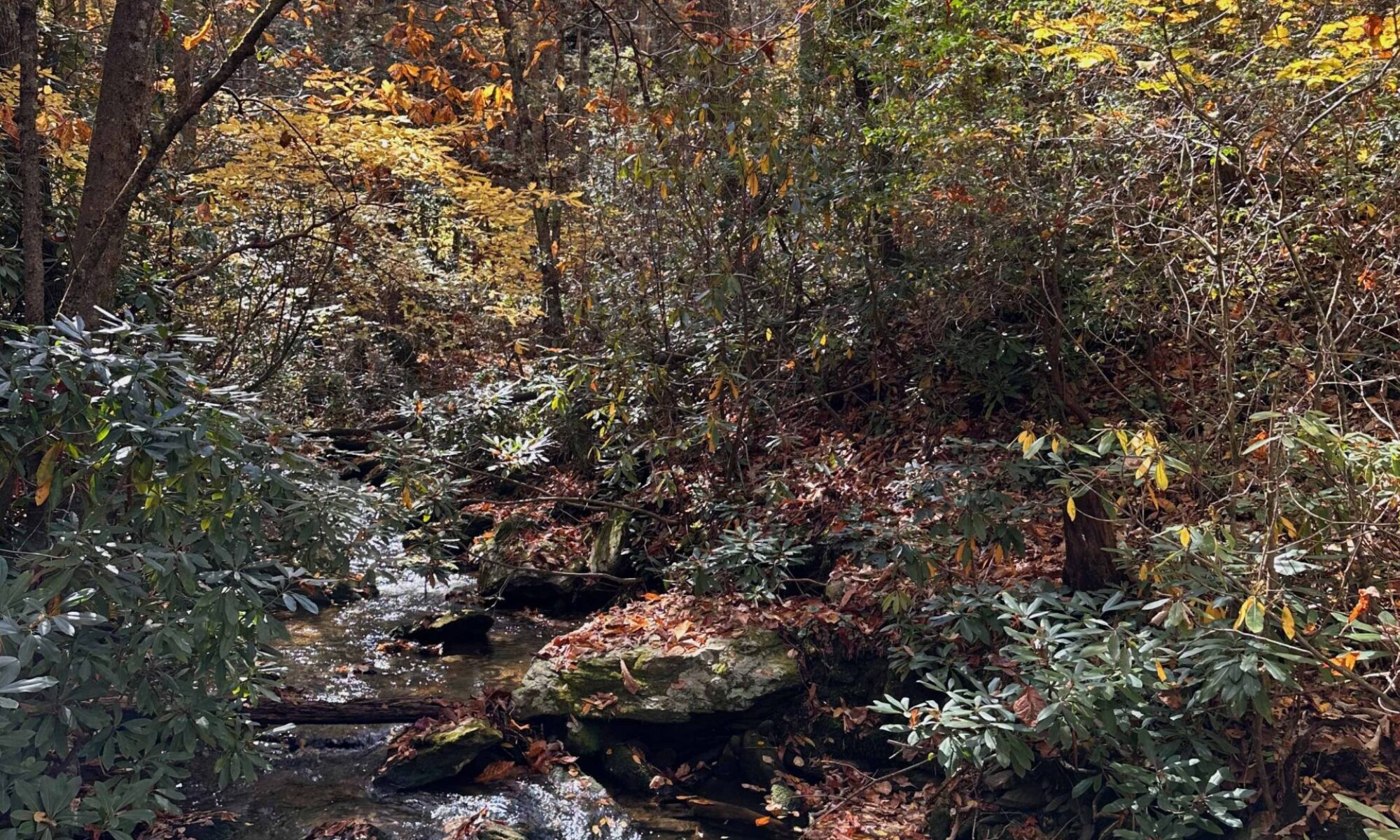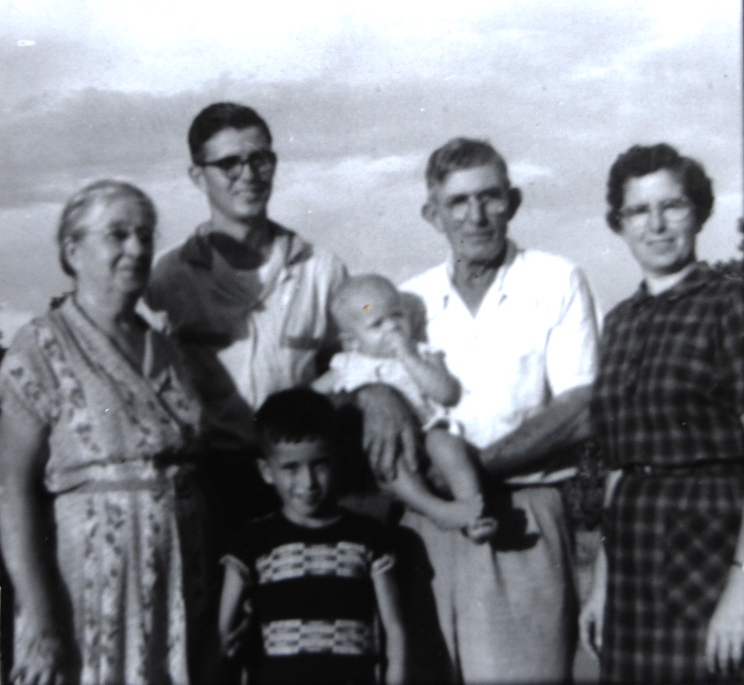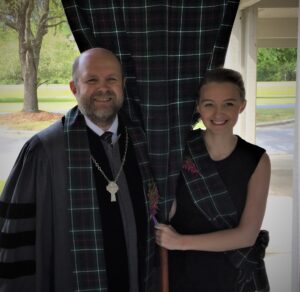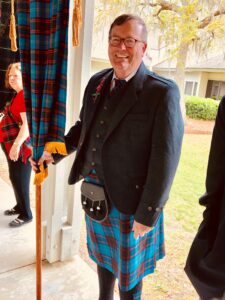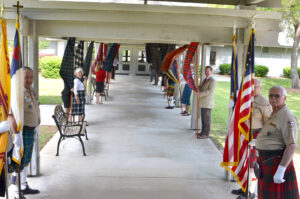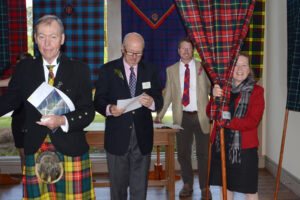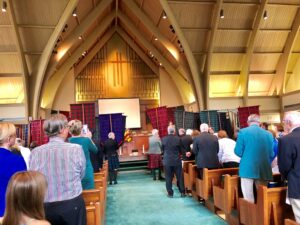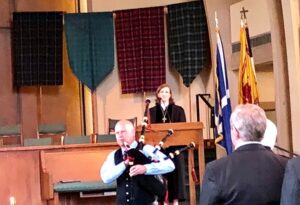On Sunday, December 13, the Presbytery of the Peaks installed me as pastor. Normally, such worship services are filled with clergy from local churches, local politicians are invited, and there’s a big reception afterwards. Not this year. Not with COVID. First of all, we had to do it where we could maintain social distance. Neither church is large enough to have more than 40 people or so safely in worship. We were blessed when Meadows of Dan Baptist Church allowed us to hold the service in their sanctuary.
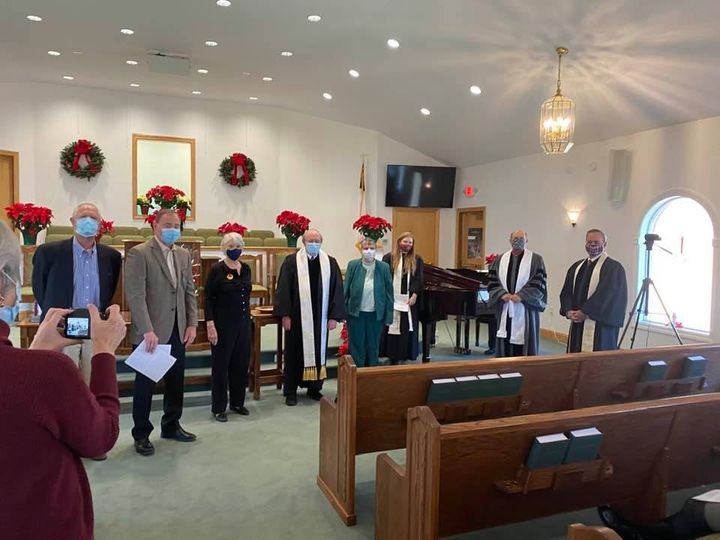
The service is led by a commission that includes Ruling Elders and Teaching Elders (ministers) from area churches. The Commission included Ruling Elders Rick Rudolph and Mike Nyquist of Mayberry, Ruling Elder Libby Wilcox of Bluemont, Ruling Elder Sue Bentley of Northside Church in Blacksburg, the Reverend Bob McL. of the Presbyterian Church of Floyd, the Reverend Sara Jane Bush Nixon of New Dublin Presbyterian Church, and the Reverend Steve Willis, Vice Moderator of the Presbytery. While there was no singing due to COVID, instrumental music was provided by Joey Webster and Lil. Puckett.
The YouTube Link is to the entire service is below. Under that are the text of Sara Jane’s sermon on Exodus 3:1-11 and Matthew 16:13-18, the charge to me given by Bob, and the charge to the congregation by Libby.
Sermon by the Rev. Sara Jane Nixon
A long, long time ago, God’s people were in slavery. A long time ago, they were being threatened with extinction, literally, with the killing of their children and the death of their adults through long, hard labor. But before that, before their slavery, before they were a nation, before the foundation of the world, before anything that ever was or is or will be was made, God had laid the plan for their redemption. Long before time began, God planned for Moses. And through immense dangers, through genocide, through murder, through exile, God preserved him and kept him. And when the time was right, God got his attention through a burning bush. And he said to him, “Go. I am sending you to Pharaoh to bring my people out of Egypt.”
But despite all that effort, despite the plan that had been in place since eternity, despite the fact that we tell this story about Moses so many thousands of years later, it’s remarkable how little of this passage is actually about Moses. It’s the Lord who has seen the misery of his people in Egypt, the Lord who has come to rescue them, the Lord who has come to bring them into a good and spacious land, the Lord who has heard, the Lord who has seen, the Lord who sends. And when Moses asks why him, the Lord has nothing to say about Moses as a person. Nothing about how excellent his moral character is, nothing about his leadership qualities, his extroversion, his teaching abilities. None of that seems to matter. All God has to say on the subject is “I will be with you.” It’s not about Moses. It’s about God.
And when Moses still has hesitations, still has doubts, God’s reassurance still doesn’t have anything to do with him. “But God, what if they ask me who sent me? What if they ask me, who is the God of our fathers?” God gives a cryptic answer at first: “Tell them ‘I AM’ is my name.” But then he explains further: He’s the God of Abraham, Isaac and Jacob, the God the ancestors knew. He hasn’t forgotten, he’s still the same.
Gallons of ink have been spilled over what it might mean for God to say that his name is “I AM.” But it at least seems to imply God’s active presence, active commitment to being the same God at all times and in all places. The God of the fathers – Abraham, Isaac, and Jacob – is I AM. The God of Moses and the Exodus is I AM. The God of the future is I AM. “This is my name forever,” says God, “the name you shall call me from generation to generation.” It’s a promise. Who am I? Says God. You’re gonna find out. You’ll find out by my faithfulness, my unfailing love, from generation to generation to generation forever. Whatever else changes, my faithfulness, my commitment, my love for my people will not. That’s how you’ll know me. From generation to generation. Forever.
And they did. We did. Most of all through the birth and life and death and resurrection of Jesus Christ, God and Son of God, firstborn of all creation, the Word from before the beginning who was made flesh and walked among us, full of grace and truth. But that self-revelation of God in Jesus is not always clear – not at all times, not for all people. It wasn’t even necessarily clear for the people who knew Jesus the best. It’s a secret – a mystery, in the biblical sense of the world. A biblical mystery isn’t like playing Clue, where you’ve got to figure out who killed the butler in the library with a candlestick. It’s something you need to have revealed to you by someone else. It’s a secret you can’t know unless you’re told.
And so when Peter comes out with his true and history-changing recognition that Jesus is the Christ, the true king of Israel, the Lord and God of the universe, who has come to rescue his people like a new and second and final Moses, Jesus praises him. Blessed are you, Simon son of Jonah! But he still doesn’t get the credit.
He doesn’t know it by himself. It’s God who has revealed it to him, God who has made it known, God who has revealed the mystery of Jesus’s identity to him.
And in recognition of the moment, Jesus changes Peter’s name. He makes a pun on the Greek words, “Petra,” rock, and “Petros,” Peter. Don’t ever let anyone tell you Jesus isn’t funny. “You are Petros, Peter, and on this Petra, rock, I will build my church.”
“Hey Rocky, I’m gonna build my church on this rock.” But the emphasis here still doesn’t fall on Peter. It’s not about what a great leader Peter is going to be. It’s not about how perfect he is – because spoiler alert, he absolutely was not. Peter becomes the Rock on which Jesus built and is building his church not because of who he was, but because of who Jesus is.
Because Jesus is the Christ, the Son of the Living God, and because God revealed that to Peter and enabled him to make that profession, Peter is the Rock. And if God has revealed it to you, and enabled you to make that profession, you’re a rock too, a rock that God is using to build his kingdom. And God makes a promise, too. He promises that he’s not building in vain. Even if the gates of death and hell try to overrun that kingdom – and they will – they won’t succeed. The God who promised to be there from generation to generation promises that nothing will stand in the way of bringing his kingdom to earth, making it, as we say, on earth as it is in heaven.
Up till now, he’s kept that promise. He’s kept it through plagues and wars, through seismic shifts in the fabric of society, through more assualts of Hell’s gates than even the history books can keep up with. Despite all the odds, despite our enemies and more often than not our own stupidity, here we are. Despite these last nine months, here we are. Nothing is the same as it was. We could not have imagined our present last year, and next year is even more uncertain than usual. Here we are in an uncertain present, struggling into an unknown future.But even here – especially here – God delights to show us his faithfulness. He delights to open a new chapter and a new promise in your life, Jeff, and in your lives, Mayberry and Bluemont, in your new life together. The gates of Hades, the gates of Death, they’re raging. But from generation to generation, God shows himself to be the God who is with us here, wherever “here” is. And here in the Rock churches – made up of physical rocks, yes, but also the spiritual Rocks of those who make the proclamation that Jesus is the Christ, a new thing is happening. A pastor and two churches are coming together to live out that profession and the promises that follow it in a particular time – 2020 – in a particular community. You’re here as a pledge and a witness that even here, even now, God is building his kingdom.
And of course, you’ve all got dreams, hopes, aspirations, expectations for your time together. Some of them are reasonable and right and achievable, some of them, undoubtedly, will turn out to be fantasy. Jeff isn’t going to manage to be a perfect pastor.
Bluefield and Mayberry aren’t going to quite manage to be perfect congregations.
But that won’t matter. Because just like Moses wasn’t really the point, just like Peter wasn’t really the point, y’all aren’t really the point either. The God who promised Moses that he would be I AM to his people from generation to generation, forever, has promised his presence to you as well. The God who promised Peter that the gates of death would not prevail against his church keeps his word to this day. Today, we’re celebrating a new beginning, a new chapter. But it’s a new chapter in an old, old story – the story of God’s faithfulness, his love, and his determination that we all will dwell with him in peace. And in his grace and his mercy, he’s chosen to work that out in you and in your community through your and Jeff’s ministry together, through the confession that Jesus is the Christ, through the small and everyday ways you’re building up rocks for the kingdom. It’s not going to be perfect, but it doesn’t have to be. God will be perfect for you, and from generation to generation, though all the gates of hell oppose him, he will not fail.
So to the God of all grace, who by the power at work within us is able to accomplish far more abundantly than all we could ask or think, to him be glory in the church and in Christ Jesus, now and forever. Amen.
Charge to the Pastor by Rev. Robert G. McLavey
Jeff, it is a joy and a privilege to welcome you to the neighborhood. I came to Floyd—just down the parkway—a little over five years ago. I, too, came from a large city—Denver, Colorado. But it did not take long for me to feel at home in the beautiful surroundings of the Blue Ridge Mountains. The people here are wonderful, and the history is rich. There is a faithfulness in the people, where you know that God has been at work for a long time, using some real pioneers who either grew up here or came here when the area was a pretty tough place. But God’s grace is strong, indeed, and we are the beneficiaries of those who have come before us to preach the good news of Jesus Christ. And that has been true throughout the history of Christ’s church.
In the Apostle Paul’s letters to Timothy, Paul passes on to his spiritual heir the wisdom accumulated through a life of mission, ministry, and suffering for the gospel. In 1 Timothy, chapter 6, Paul says, “But you, man of God,…pursue righteousness, godliness, faith, love, endurance and gentleness. Fight the good fight of the faith. Take hold of the eternal life to which you were called when you made your good confession in the presence of many witnesses.” In the first chapter of 2 Timothy, Paul says, “What you heard from me, keep as the pattern of sound teaching, with faith and love in Christ Jesus. Guard the good deposit that was entrusted to you—guard it with the help of the Holy Spirit who lives in us.” And, finally, in the fourth chapter Paul says, “In the presence of God and of Christ Jesus, who will judge the living and the dead, and in view of his appearing and his kingdom, I give you this charge: Preach the word; be prepared in season and out of season; correct, rebuke and encourage—with great patience and careful instruction.”
Jeff, let me suggest that in this day and age, being a minister of Word and Sacrament is not enough to ensure that Jesus is held up in honor and glory. Yes, preaching the Word and rightly administering the Sacraments are essential parts of our calling, but we also must be living examples of truth. We must speak with love and authority. We must call out false teachers who speak with hatred and hypocrisy in the name of Jesus.
And to do all of this, Jeff, you must take care of yourself. You need to be fed spiritually, you need to be diligent in getting rest and inspiration, be sure to spend quality time with your wife and family, and you must be certain to take time to be in solitude with God. As you are surrounded by these beautiful Blue Ridge Mountains, realize that God’s creation is yet another example of his majesty and another testament to his sovereignty.
Jeff, by accepting a call to these congregations in this community, a great treasure is committed to your care. The people you serve are the flock of Christ for whom he gave his life. Therefore, I charge you to never stop loving Jesus the Shepherd, and never cease caring for his sheep. Labor faithfully on their behalf and do everything in your power to bring all those entrusted to your care to mature faith and the knowledge of God. Seek to be one with Christ in all you say and do.
Let me leave you with this delightful thought. All of us who have studied in seminaries and have prepared for ministry by pouring over books of great theologians have encountered the writings of Karl Barth, the renowned professor at the University of Basel in Switzerland. He was the most prolific theologian of the twentieth century, and his theology was as complex as it was profound. But when Barth visited the University of Chicago on a visit to the United States, and as students and scholars crowded around him at a press conference, someone asked, “Dr. Barth, what is the most profound truth you have learned in your studies?” Without hesitation, he replied, “Jesus loves me, this I know, for the Bible tells me so.”
Jeff, may that be your greatest truth, as well. Share it with your congregations and the world!
To the glory of God. Amen.
Charge to the Congregations by Ruling Elder Libby Wilcox
Friends in Christ,
There are few words that can express my excitement for this celebration of installation. As chairman of the PNC, my committee has worked for the past year to find just the right pastor for our churches. With God’s guidance, we have done just that. Today, I come before you as an Elder, with the charge for both congregations. This day is full of hope for the future. We have discerned in Jeffery Garrison the gifts of preaching and teaching and have called him to serve among and with us. In the Congregational tradition, it is the body of Christ – all of us together – that blesses this installation to ministry. No bishop examines or consecrates this time. It is the spirit of God, through the witnessing congregation that declares the joyful discernment and call of Jeff Garrison as our minister. Your presence here today is a vital expression of our faith.
But after this sacred celebration ends, then what? This day is not just about Jeff, it is about all of us and how we will partner with Jeff to do God’s work.
No successful, transformative, healthy ministry is ever a one-person show. If church and pastor are to form a partnership that is strong and enduring, we must honor each other as Christ has already honored us. We are all in this together. Given this, I charge you as God’s gathered people at Mayberry and Bluemont Presbyterian Churches, with these things.
First, as our years with Jeff unfold, expect to change. That is because the Spirit still broods over us, Christ still walks among us and God still calls us. As our relationship unfolds, time will continue to work changes because all authentic ministry changes us. Expect to be comforted by this as our minister establishes bonds of affection with us, but also challenged and confronted as well.
Second, remember that we are all called together as the body of Christ for God’s great purposes. Jeff is not a proxy for our work. God doesn’t need another fan club. God needs workers in the vineyard. Paul reminds us in Ephesians, there is one body and one Spirit and each of us was given Christian gifts…..some would be apostles, some prophets, some evangelists, some pastors and teacher, not for personal glorification but so the saints would be equipped for the work of ministry for the building up of the body of Christ. (Eph. 4) This world, yea, this part of the world needs to know God’s love and grace through each of us. This is a partnership of people and pastor on behalf of a mighty and merciful God. We are embarking on holy work.
Third, honor Jeff’s ministry. While this is a partnership, there is also a peculiar setting apart that happens when we grant a minister the privilege of our pulpit and he commits to this ministry before a trusting, yearning congregation. Ministry can be lonely and often there is little to go on to know if you are making a difference. A pastor is more likely to hear the vocal complainers than the quiet supporters, and is under enormous pressure to wade into conflict with wisdom beyond human capability when it gets personal. So honor Jeff’s ministry. Pray for him. Contact him – notes, texts, phone calls, emails, however – contact him with words of encouragement. Thank him for being a preacher, pastor and prophet in our midst. And honor him by challenging him, asking for clarification, sharing your viewpoint. Be full, and real and honest in your support.
The apostle Paul frequently began his letters with wonderful words of thanksgiving, as here in his letter to the Philippians: “I thank my God every time I remember you, constantly praying with joy in every one of my prayers for all of you, because of your sharing in the gospel from the first day until now.” Paul goes on to say, “I am confident of this, that the one who began a good work among you will bring it to completion by the day of Jesus Christ. It is right for me to think this way about all of you, because you hold me in your heart, for all of you share in God’s grace with me…”.
Indeed, today affirms once again that all of us are in God’s grace and are partners in the sharing of the gospel. With joy, thanksgiving and prayer, God’s good work will be manifest among us, if we give thanks for each other, honor each other, and remember that God has called us to this time and place for a reason. May you perceive this with the excitement and hope that only the Spirit can give and may our years together be marked with great faithfulness. May God Bless all of us !
